
Peter Cushing searches for the Yeti in the Himalayas, but instead finds the dark soul of Man. Hammer puts a fresh, philosophical spin on the snowman in this excellent 1957 effort, that is unfortunately a bit too talky. 7/10

The Abominable Snowman. 1957, UK. Directed by Val Guest. Written by Nigel Kneale & Val Guest. Based on teleplay by Kneale. Starring: Peter Cushing, Forrest Tucker, Maureen Connell, Richard Wattis, Robert Brown, Michael Brill. Produced by Aubrey Baring.
Three botanical researchers, John Rollason (Peter Cushing), his wife Helen (Maureen Connell) and Peter Fox (Richard Wattis) are guests of the local Lama (Arnold Marlé) at a Buddhist monastery in the Himalayan mountains. One day a team of explorers led by American climber, explorer and all-round obnoxious character Tom Friend (Forrest Tucker) arrives. Along are also trapper Ed Shelley (Robert Brown), young McNee (Michael Brill) and sherpa guide Kusang (Wolfe Morris). They are about to set off up the mountains to find the legendary yeti – an obsession of Rollason’s. Despite his wife’s worries and protests, and the cryptic warnings from the mysterious Lama, Rollason decides to join the expedition.
Thus opens Hammer’s The Abominable Snowman from 1957, directed by Val Guest and filmed just before Hammer got their smash hit with The Curse of Frankenstein (1957, review), but released after. This was the last of a handful of snowman films produced in the 50s, and according to most critics, the best. While Cushing is the actual protagonist, American guest star Forrest Tucker was first-billed. The movie was released in the US as The Abominable Snowman of the Himalayas.

After an arduous trek up the mountain, it soon becomes clear to Rollason that Tom Friend’s interest in the yeti is not scientific as such, but rather commercial, as he wants to take it back to the US and profit off it – while Rollason feels it should be left to its own devices. This starts building tension between the two.
Meanwhile, the team discover large footprints in the snow, and McNee, who is driven by an obsession to see the snowman after having glimpsed it at a previous expedition, is injured after stepping in a bear trap set by Shelley. In the night, McNee goes into a trance when the yeti comes near, as the rest of the team rush out when they hear sounds outside. When they are gone, the yeti (off-screen, apart from a large hand) visits McNee in the tent, without harming him. Rollason concludes that the yeti and McNee have some sort of telepathic connection. Sherpa Kusang also sees the yeti and heads back to the monastery for safety. When he arrives, Helen and Peter decide to launch a rescue mission. Peter visits the Lama for advice, but the Lama sits in a trance, just like McNee had, possibly having telepathic communication with the yeti.

McNee, obsessed with the yeti, climbs up the mountain on his bad leg and falls to his death. When the yeti arrives back, Shelley shoots and kills it, but the audience still only see its arm. Friend is not content with a dead yeti, but wants to capture a live one, and sets a trap in a cave, leaving Shelley as bait. The yeti finds Shelley with the body of its dead mate. The yeti breaks through the trap and Shelley fires a gun at it, but Friend has loaded it with blanks, so Shelley wouldn’t kill his prize. When he and Rollason return, they find Shelley dead from shock. Friend goes off about how the yeti is a savage monster who killed both McNee and Shelley, but Rollason counters that Friend is the real killer. Rollason theorizes that the yetis are in fact an intelligent and friendly race, hiding in the Himalayas for the barbaric human civilisation to destroy itself, so it can populate the globe.

But Friend wont hear it, instead he runs after the yeti into the mountains, and dies from an avalanche he sets off by firing his gun. In the cave, Rollason finally encounters two yeti who greet him, and then he faints. In the next clip, we see Peter and Helen discovering a half-frozen Rollason on the path to the halfway hut, where the yeti has left him for his rescuers to find. Cut again to the monastery, where Rollason has a conversation with the Lama, saying that there is no such thing as a yeti.
Background & Analysis

The Abominable Snowman was filmed before Hammer got its spectacular breakthrough with The Curse of Frankenstein, but released later in the same year, 1957. Thus, the film more closely resembles Hammer’s pre-Frankenstein output: it’s in black-and-white, largely without spectacular special effects and completely bloodless. It was co-produced with American Regal Films (behind the front of Clarion), which was a B-movie production unit run by Robert Lippert under Twentieth Century-Fox, who distributed the film in America. The standard operating procedure for British B-movies that were co-financed by American distributors at the time was that the film had to feature a recogniseable Hollywood star to draw in US audiences. After the success of The Curse of Frankenstein, Hammer was able to forego this arrangement, but since The Abominable Snowman was produced before the latter film, the agreement still stood. And while Peter Cushing was a sufficient marquee name in later years, at the time he was still mainly a TV actor and completely unknown in the US.

The film was based on the BBC TV play The Creature (1955), written by Nigel Kneale, the creator of the revolutionary TV series The Quatermass Experiment (1953, review), which had been so successfully adapted by Hammer as The Quatermass Xperiment (1955, review) and Quatermass 2 (1957, review). Kneale also wrote the script for the movie, which is apparent from the philosophically slanted and talky script. Director was Val Guest, who also directed the Quatermass films, so everything was set for another triumph.
The world had yeti craze in the early 50s as stories of the abominable snow man started circulating in the western press, after climber Eric Shipton had published pictures of “yeti footprints”. The myth gained further traction when Mount Everest conqueror Edmund Hillary reported seeing similar footprints, and in 1954 Daily Mail sponsored a highly publicised trek to the Himalayas to find the yeti. W. Lee Wilder is often credited with directing the first yeti movie, The Snow Creature, in 1954 (review). However, he was actually beaten to the Finnish line by the Finnish comedy Pekka ja Pätkä lumimiehen jäljillä (“Pekka and the Stump on the Snowman’s Trail”) by a couple of months (review). A third yeti movie was made by Ishiro Honda in 1955, called Ju jin yuki otoko (review), released as an Americanised version with narration by John Carradine as Half Human. In 1956, Jerry Warren made the clunky Man Beast (review). The Abominable Snowman was the fourth and last yeti movie of the 50s, and – if I’ve done my research correctly – was actually the last English-language feature film ever to feature a Himalayan yeti.
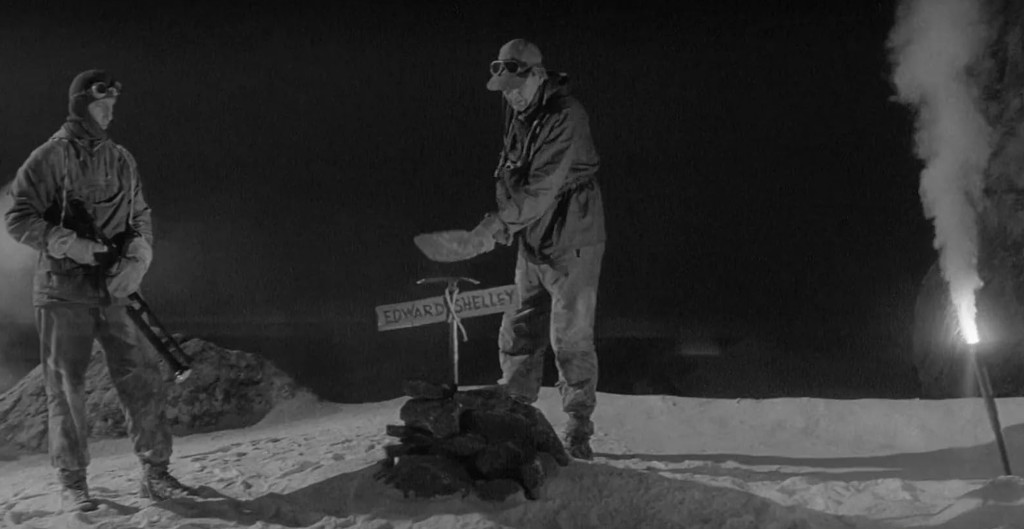
Despite its apparent low budget, The Abominable Snowman is a visually impressive film. Guest took doubles of the five main characters and went to the French Pyrenees for ten days to film mountain climbing footage and spectacular vistas, and production designer Bernard Robinson has built a convincing Himalayan set at Pinewood Studios, after Hammer realised their home at Bray Studios was too small. The set pieces were made on wheels so they could be put together in different configurations. The artificial snow was made of polystyrene and salt. The monastery set, however, was built at Bray, and it is also beautifully realised. For added realism, members of a Buddhist temple were brought in to choreograph the monks dancing. The set was later reused in the 60s TV series Fu Manchu, starring Christopher Lee. The combination of the Pyrenees footage and the studio-bound Pinewood footage is very well realised, thanks to Bill Lenny’s editing and Guest’s smart direction. The movie’s visual prowess is enhanced by its anamorphic wide-screen format, filmed in what was dubbed alternatively as “HammerScope” or “RegalScope”, depending on where it was shown. In reality, this was simply Fox’s CinemaScope format, in black-and-white.

One thing, however, that will irk all the people who are expecting a monster movie is the conspicuous lack of monster. There is much talk of the yeti, we hear the yeti and we see people looking at the yeti, but we see very little yeti throughout the film. When it visits the explorers’ tent, we only see its hand. Even when the first yeti is shot, and the characters stand around it, we only see one of its arms. And at the end, when Rollason finally encounters them, they are largely obscured in shadow, with only half of one yeti’s face visible in the light.

Partly, this stems from the fact that the movie was adapted from a live television play, where, of course, special effects were out of the question. Nigel Kneale also said about the film that he couldn’t count on spectacular special effects, because he knew he wasn’t going to get any. Kneale knew that anything Hammer put on screen would be far less impressive than what viewers conjured up in their heads, and that whatever the studio came up with would be a disappointment. And by showing a yeti early on in the movie, he would have ruined all its mystique. One of the reasons the film holds up as well as it does today is that it isn’t hampered by an amateurish monkey suit, as in many other similar films.
But another reason is that this is not really a film about the yeti at all, it is a morality play about humanity. Kneale said that he wanted to turn the idea that the yeti was a brute that civilised humans were looking for on its head. What if it was actually the other way round? Kneale’s idea may have been inspired by Frank Capra’s 1937 film, based on James Hilton’s 1933 novel, Lost Horizon, in which explorers find a hidden pacifist civilisation in the Himalayas, waiting for the rest of mankind to annihilate itself so it can repopulate the world.

Nigel Kneale’s science fiction output was always heavy on philosophy and ruminations on the human condition, and he hated that Hammer turned up the horror element in the adaptations of his Quatermass movies. Val Guest, who directed several of Kneale’s scripts, also was responsible for re-writes, which Kneale never quite approved of. This is the case with The Abominable Snowman as well, even if Guest didn’t take any screen credit for it. Guest told film historian Tom Weaver that he removed large chunks of dialogue that he considered unnecessary. Nevertheless, this is still a talky film with very literate language. Even Kneale’s brutes were well-spoken. Guest, who held Kneale in high regard, said that he was a wonderful writer of literature, but didn’t know how to write movie scripts.
But it is Kneale’s writing that elevates this film to what director Joe Dante calls the best film ever made about the abominable snowman – precisely because it is not about the abomible snowman, in the same way that Gojira (1954, review) wasn’t really about a giant prehistoric reptile. As British critic Robin Bailes puts it at Dark Corners: “this is about the hunt more than about the capture, and more about the creature and what drives them than about the creature, making this as close to Moby Dick as it is to King Kong. […] Kneale is concerned with the men and with humanity as a whole.” As Rollason says at one point in the film: “It isn’t what’s out there that’s dangerous, it’s what’s inside us”. It is crucial that the snowman never kills anyone. McNee is driven to his death by his obsession with the snowman, and it is essentially Friend who kills Shelley by loading his gun with dummy rounds. All the while, Friend keeps blaming the snowman for the deaths, until he himself is killed in an avalanche that he causes by firing his gun, despite Rollason’s warnings.
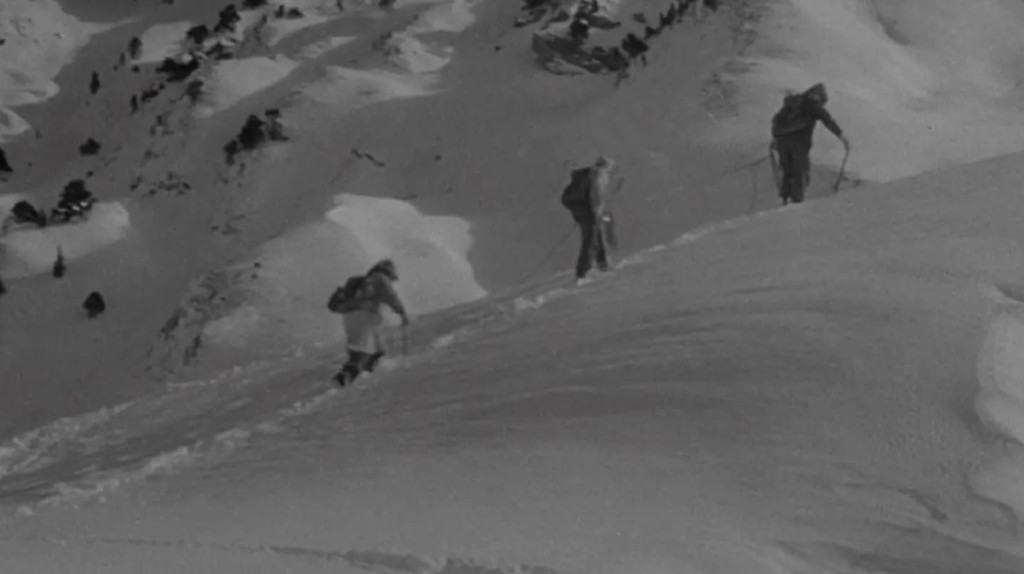
Tom Friend is the real antagonist of the movie, incorporating the cynicism, selfishness and disregard for both nature and people that Kneale despised. Both trapper Ed Shelley and Rollason’s colleague Peter Fox display a disdain and revulsion for the Tibetian people, their lifestyle and culture, while Rollason and his wife are conversely fascinated and appreciative of them. Likewise, Shelley and Friend see the yeti as just a barbaric ape, while Rollason is open-minded enough to realise that it is an intelligent and even civilised creature – and morally in fact more high-standing than the human race.
It is the antagonism between Rollason and Friend that drives the film forward, Friend viewing the the yeti is a big game prize to be captured and exploited, while Rollason considers it a being with a right to its own peace and freedom. But it’s not only Rollason’s and Friends intentions for the yeti that clash, but their entire world-views. Nevertheless, Kneale doesn’t turn Friend into a one-dimensional character, but also shows sympathy and understanding for him, arguing that it is circumstances that have shaped him into what he is, rather than ill intent. The script also showcases a mutual respect between Friend and Rollason, and shows the antagonist’s more sympathetic and civilised side, preventing the film from sliding into simplistic notions of black and white.

Rollason’s wife and colleague were not present in the TV play, but were suggested to Kneale by Peter Cushing, who wanted to flesh out the character of Rollason and get a woman’s perpective on the hunt for the yeti. Rollason’s conversation with Helen and Peter do help to give Rollason more humanity and and character, but I’m not sure the “woman’s perspective” adds much to film, as a “woman’s perspective”, according to Kneale and Cushing, primarily seems to consist of being worried. Kudos, though, for not turning Helen into a shivering wallflower, but giving her some agency and setting out on a rescue mission. The character was named after Cushing’s wife Helen.
Several actors reprised their roles from the TV play, broadcast as an episode of BBC Sunday-Night Theatre on the 30th of January, 1955. This included Peter Cushing as Rollason, Arnold Marlé as the Lama and Wolfe Morris as Kusang. The crucial role of Tom Friend was played on TV by Tom Baker, an actor primarily known for playing villains. But as the movie needed an American star, Hammer swapped him for Forrest Tucker, who, while no stranger to playing henchmen and roughnecks, was better known for heroic roles. Interestingly, Kneale who hated US star Brian Donlevy’s turns as Professor Quatermass, liked Tucker, and told biographer Andy Murray that he thought Tucker was on par with Baker, albeit played the role in a more extroverted manner. Director Guest, on the other hand, said “Forrest Tucker might have been very good at some things but, to many people’s minds, acting wasn’t one of them”.
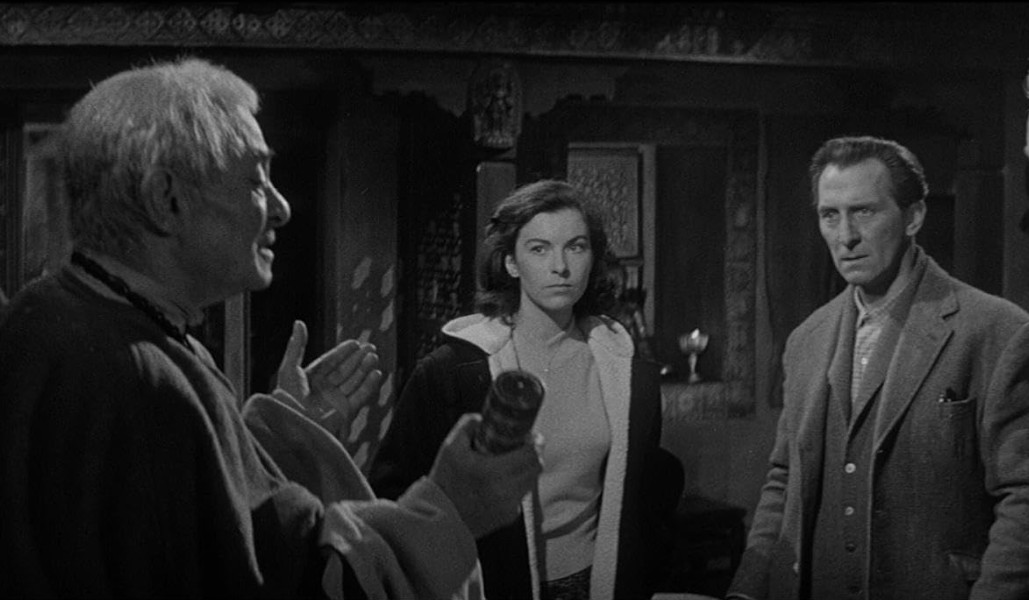
One thing that may irk a modern viewer is the fact that the two major Tibetan roles are played by Caucasian actors. Of course, this can be chalked up to the fact that Hammer probably didn’t have access to many Asian actors – but on the other, hand, if they could fly in an American star, it couldn’t have been impossible to find two Asian actors in London. The effect is particularly noticeable, as the monastery seems to be teeming with Asian extras – these were primarily waiters from Chinese restaurants around London.
There is no doubt that this is the best yeti movie made in the 50s, perhaps even in the entire history of cinema. That said, the bar is not particularly high. Both the pros and the cons stem from the same source: Nigel Kneale. Kneale was an ideas man who wrote intelligent, thoughtful and philosophical scripts without pandering to the audience. But he also had a tendency to labour his points through drawn-out philosophical dialogue with sentences no human being has ever uttered, but rather feel like something written in a book. His best movies were those in which he had Val Guest as a director, who understood and admired what Kneale was trying to do, but also wasn’t afraid of using his red pen to strike out Kneale’s meandering dialogues where he thought it was necessary. In The Abominable Snowman, he could have used it with a heavier hand.

But Guest was also a fantastic director, who knew, more than anything, how to build tension and atmosphere. The ten-day trip to the Pyrenees pay off handsomely, giving the story a majestic setting, but also reminding the audience of how utterly small and alone the protagonists are in the Himalayan mountains. And despite the magnificent vistas, this is a film that is claustrophobic to its core, with much of the action taking place in tents, caves and nigh-impassable crevaces and passages beneath the mountains, often in darkness and with a feeling of overhanging doom. The protagonists are kept as in a pressure cooker, all grinding against each other, and one after one they all snap under the pressure. It’s a small masterpiece of psychological horror. For the film, Guest wanted to keep the same documentary feel that he had employed in the Quatermass films, including use of handheld cameras and overlapping dialogue. This adds to a certain degree of realism and thus heightens the horror and suspense, but also clashes with Kneale’s literary dialogue.
One problem with the movie is that there are too many ideas that are never elaborated on. The monks seem to both fear and revere the yetis, but their relationships are never clarified. The Lama seems to disapprove of the expedition, but does little to dissuade Rollason from embarking on it – almost seemingly egging him on. It is insinuated that the yetis have telepathic powers, affecting both McNee and Rollason, and the Lama seems to be in telepathic contact with them. However, this plots strain is ultimately redundant, and the few instances in which it comes to play have no real significance to the story. There’s a lot of “seems” in here, because, despite the lengthy conversations, Kneale refuses to confirm much of anything. In and of itself, this is not necessarily a bad thing, and it is refreshing with with a 1950s monster movie that doesn’t write its messages and plot twists on the nose. But the level of vagueness in The Abominable Snowman is such that it leaves the viewer with a sense of unresolved business.

One can applaud both Kneale and Guest for keeping the audience guessing about snowmen instead of revealing a cheap ape suit in the middle of the movie, effectively deflating all tension. But as the movie proceeds, it starts feeling more and more like a financial decision, rather than based on storytelling – as if Hammer simply didn’t have the resources to make a good yeti suit. This feeling is further strengthened in the end, when we finally see the yetis, but only as backlit silhouettes, apart from a closeup where half a face is revealed. And despite the fact that Hammer showed a full-size snowman covered in a tarp, with arms and legs esxposed, Guest didn’t even use this in the movie. And once we meet the yetis, the film wraps up way too quickly, leaving us with more questions than answers, feeling a bit short-changed.
Nevertheless, this is a taut, intelligent, visually impressive and well-directed little low-budget gem, despite being occasionally meandering and ponderous.
Reception & Legacy

The Abominable Snowman was overshadowed by the success of Hammer’s The Curse of Frankenstein and performed poorly at the box office both in the UK and the US. Another reason for its weak performance may be that the adolescent crowd frequenting science fiction and monster movies found the film to containt too much talk and too little snowman. In the UK it was paired with Warner’s teen movie Untamed Youth, starring Mamie van Doren, and in the US with Regal’s diving-themed adventure movie Ghost Diver.
However, reviews for the movie were, supposedly, largely positive in the UK; Derek Hill at the Evenening Standard called it “among the best of British science-fiction thrillers”. However, The Monthly Film Bulletin complained it was “a disappointingly tame and ineffectual screen version of Nigel Kneale’s intriguing TV play”. The US trade press was positive. Harrison’s Reports said the film offered “considerable suspense and excitement”, and the Motion Picture Exhibitor wrote: “There is a goodly amount of suspense and action with story interest buily throughout the running time. The cast is efficient and production and direction good”. The Motion Picture Daily said it was “produced in such a way that the audience will probably never be conscious of what was probably a fairly low budget”.

In The Encyclopedia of Science Fiction Movies, Phil Hardy felt that The Abominable Snowman “lacked subtlety” in comparison to the Quatermass films, and that “Kneale’s teleplay was far stronger than this rather weak, but well filmed, offering”. Bill Warren in his book Keep Watching the Skies! praised Kneale’s effort to do something different with the yeti trope as “responsible and intelligent”, but thought the movie as a whole was “ponderous and hence unexciting”.
Today the film has a rather good 6.4/10 rating on IMDb, based on a rather impressive 5,000 votes, and a 3.2/5 rating on Letterboxd, based on well over 3,000 votes.
Richard Scheib at Moria gives the movie 3/5 stars, writing: “Nigel Kneale’s script here is tightly built and well characterised. Unfortunately, the ending disappoints. The entire film is built to an expected confrontation with the Yeti – but at the point of the meeting between humanity and the Yeti, the film enigmatically and unsatisfyingly fades out, giving only a briefest glimpse of the Yeti.” Mark Cole at Rivets on the Poster says: “It is a creepy little film that wrings as much out of its desolate surroundings and terrified characters cut off from the rest of the world as it can. Hammer made few better SF Horror films. Unfortunately, far too many modern viewers will feel cheated by the creature’s almost non-existent screen time.”

The Abominable Snowman was the last hurrah of the short-lived yeti-fascination in the movies with the yeti between 1954 and 1957. In fact, a search on IMDb on the tag “yeti” doesn’t turn up a single English-language feature film after 1957 that features a yeti in a Himalayan setting, and not very many in other languages either. There were a few TV movies over the years, and a number of feature films that include yeti-like creatures in other parts of the world, and a number of films featuring supposed yetis that turn out to be something else. Considering the yeti is such an iconic monster, it is astonising how few yeti films have been made after the 50s.
Director John Carpenter was a devoted Hammer fan, and it is not hard to see the influence of The Abominable Snowman’s Arctic claustrophobia in Carpenter’s The Thing (1982).
Cast & Crew
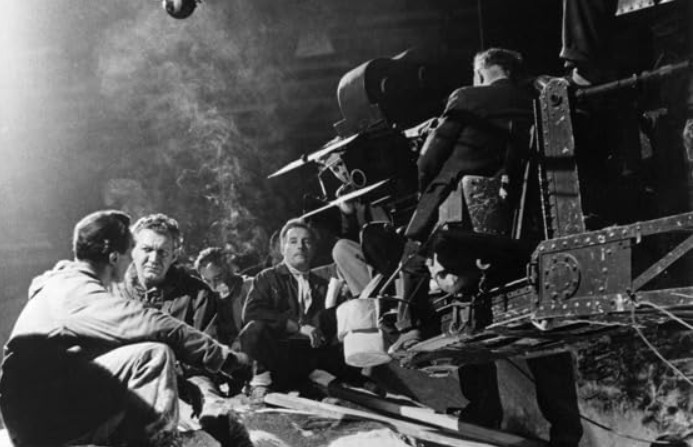
Director Val Guest is a household name in science fiction, and he is best known for completely altering the direction of Hammer Films in the fifties by writing and directing The Quatermass Xperiment (1955, review) and Quatermass 2 (1957, review). While classics of SF, it was the horror elements of these movies that Hammer executives saw appealing to audiences, and this was how Hammer Horror was born.
Born in London in 1911, he tried his hand at acting in the late twenties and early thirties, and in 1934 became the one-man UK office of The Hollywood Reporter. Incensed by Guest’s comments about the quality of director Marcel Varnel’s latest film in his regular column, Varnel challenged Guest to write a better script himself. The result was a collaboration on the Gainsborough Pictures production No Monkey Business. The studio liked his work, and signed him on. Val Guest wrote dozens of comedies for Gainsborough and other studios in the thirties and forties, and gradually started doing a little bit of uncredited second unit directing here and there, and in 1942 directed his first short film, an Arthur Askey educational reel about the perils of sneezing. His feature debut was a musical comedy called Miss London Ltd. (1943). And he got his first brush with science fiction in the field of comedy, directing Mr. Drake’s Duck (1951, review), a film about a duck that lays a radioactive egg. It was also comedies that took Guest to Hammer in the early fifties, when he was offered to direct a low-budget Robin Hood film, The Men of Sherwood Forest (1954).

After directing the Quatermass films and The Abominable Snowman (1957), Guest returned to his bread-and-butter genre, comedy. But as fate would have it, he wasn’t to remain out of SF territory for long. In 1961 he co-wrote and directed the classic apocalypse film The Day the Earth Caught Fire. In 1970, Guest’s star had waned and he found himself doing super-cheapos, such as the belated pop comedy Toomorrow, a film with the moronic premise that dying aliens kidnap a pop group because they need their “vibrations” to live. The same year, he directed the low-budget prehistoric film When Dinosaurs Ruled the Earth, perhaps best remembered for featuring Victoria Vetri. In the seventies, Guest gradually moved over to TV, and co-wrote and directed a few SF episodes on series like Space: 1999 and Hammer House of Horror and Mystery.

Apart from his love for comedies, Guest was also a fine director of crime dramas, best know is probably Jigsaw (1962). And apart from his Quatermass fame, he is probably best remembered to a broader audience because of his involvement with the ill-fated James Bond spoof Casino Royale (1967). Guest was one of the many writers on the project, and was hired as the director in charge of splicing all the different pieces of the film together into one coherent narrative.
Writer Nigel Kneale initially educted himself as a lawyer, but but soon left the profession behind and started studying acting in the mid-40’s, while also beginning as a radio actor, reading some of his own short stories on the air. After having finished his studies, he published a story collection, which won the Somerset Maugham award, and encouraged him in his writing, he left his short and uneventful acting career behind. He became a staff TV writer at the BBC in 1951, and graduated to the head of the TV drama writing department in 1952, where he struck up a fruitful companionship with fellow writer and director Rudolph Cartier.

In Europe, most countries had a single, often state-owned TV company that sort of could do whatever they pleased, and often simply filled the managerial posts with radio people. This meant much of early European TV was simply radio with pictures, and that was exactly the way Kneale and Cartier felt about the BBC. Especially the drama productions were often little more than filmed stage plays.
So when Kneale was called in to write six half-hour episodes of a new series to fill in gaps in the programming, he saw his chance to create something new and innovative, that would push the medium of TV further. Although never a big science fiction fan, Kneale loved horror stories and was fascinated by science, and when you combine these, you almost inevitably get sci-fi. Kneale was also an avid cinema-goer and was especially inspired by what he had seen done in American films. Latching on to current events and the American SF trend, the result was The Quatermass Experiment (1953). The show catapulted Kneale to fame, making him one of the most popular TV writers of his time. It also led to a second Quatermass series, Quatermass II (1955).

Nigel Kneale left BBC after his contract ran out in 1957, and immediately adapted the second series into a screenplay for Hammer, becoming Quatermass 2 (1957). 1957 was also the year he wrote the screenplay for The Abominable Snowman for the studio that really hit its stride with The Curse of Frankenstein – also in 1957 (review). Kneale wrote a third series for BBC as a freelancer, Quatermass and the Pit, in 1959, and like the previous shows it was directed by Cartier. This time he had a markedly bigger budget of one million pounds to make the series, and it is considered by many as the best of the three. Again Kneale wrote a film adaptation for Hammer, but the movie version of Quatermass and the Pit wasn’t released until 1967. Quatermass received a fourth and final series on the commercial channel ITV in 1979, again written by Kneale.
But Kneale and Cartier weren’t quite done shocking the fifties audiences yet. Encouraged by The Quatermass Experiment, they went to work on a two-hour TV film, released within the confines of BBC Sunday-Night Theatre, an adaptation of George Orwell’s Ninenteen Eighty-Four, shown in 1954. The BBC received hundreds of complaints from viewers that thought the episode was gruesome and hideous and unfit for TV, and there was even a question filed in the Parliament about it. BBC even considered cancelling the second broadcast of it. But then word came from Buckingham Palace that Queen Elizabeth had watched it, liked it very much, and couldn’t wait for the second broadcast. With that, the matter was settled.
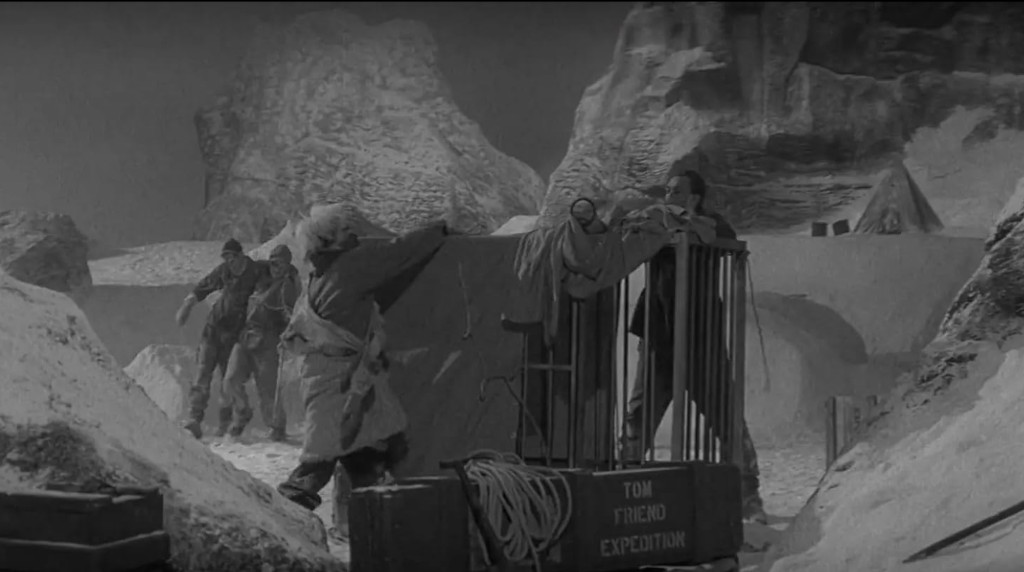
Nigel Kneale specialised in writing horror scripts, well-remembered for penning the six hour-long episodes for the mini-series Beasts (1976), but despite his outspoken dislike for sci-fi, he couldn’t stay away from the genre. He also adapted H.G. Wells’ book into First Men in the Moon (1964), wrote the TV movie The Stone Tapes (1972), probably the first film in which scientists use modern technology and computers to catch a ghost, and wrote the comedy sci-fi TV series Kinvig (1981). Approached by producer John Carpenter, he agreed to write a script for Halloween III: Season of the Witch (1982). However, he disliked the re-writes by the director so much that he had his name removed from the film. He was also approached to write scripts for The Twilight Zone and The X-Files, but declined.

With his laser focus and piercing blue eyes, Peter Cushing became an almost instant horror icon in 1957, after his turn in The Curse of Frankenstein. For two decades he became synonymous with Hammer horror, making his own the characters of Victor Frankenstein, Abraham van Helsing and Sherlock Holmes. Cushing, born in 1913, pursued acting at a young age, appearing on stage before making a brief detour to Hollywood 1939-1941. After serving in WWII, he returned to the stage and in the early 50’s became a minor star of British TV, which at the time consisted mostly of teleplays — his performance in the BBC adaptation of 1984 is particularly well remembered. He also has the distinction of being one of the many Dr. Who’s, even if he never played the character in the TV series, but in two rather poorly received movie spinoffs in the mid-60’s. Cushing found a whole new audience in 1977, when he appeared as the ominous Grand Moff Tarkin in Star Wars (1977). Cushing retired in 1986 and passed away in 1994. He won a best actor BAFTA in 1956, and has been awarded several lifetime awards for his contribution to genre cinema. In 1977 he was nominated for a best supporting actor Saturn Award for Star Wars.

While best known as a horror actor, Peter Cushing appeared in 18 science fiction movies. Cushings SF films include: 1984 (1954), The Curse of Frankenstein (1957), The Revenge of Frankenstein (1958), Dr. Who and the Daleks (1965), Island of Terror (1966), Dalek’s Invasion of Earth 2150 A.D. (1966), Frankenstein Created Woman (1967), Night of the Big Heat (1967), Frankenstein Must Be Destroyed (1969), Scream and Scream Again (1970), Horror Express (1972), The Creeping Flesh (1973), Frankenstein and the Monster from Hell (1974), At the Earth’s Core (1976), Star Wars (1977), Shock Waves (1977) and Biggles (1986).

American Forrest Tucker started as a singer and comedian in vaudeville in his teens in Chicago, and worked on stage in Washington, D.C. at a young age, before travelling to Hollywood in 1940, where he got was cast mainly for his burly physique, and became a mainstay as a brawler or henchman in westerns. However, he soon got to show his comedic timing in the lead of the screwball romcom Emergency Landing (1941), for PRC, which won him a contract with Columbia. Columbia provided mainly supporting roles, for some of which he was borrowed by major studios, and in 1948 he jumped ship to Republic, which thanked him with a few starring roles, two of which came at Paramount. In the early 50s he also made his first of several films in England, as a Republic co-production. He had starred in the TV series Crunch and Des in 1955-1956 and returned to the big screen with a top billing in Fox’s The Quiet Gun (1957), before heading back to England to shoot The Abominable Snowman (1957), The Strange World of Planet X (1958, review) and The Trollenberg Terror (1958). The same year, he had a role in Auntie Mamie, the highest grossing film in the US in 1958.

1958 also saw Tucker return to the stage for a national touring production of The Music Man, which he performed over 2,000 times over the next five years, and followed up with work on Broadway in 1964. He was then cast as Sgt. Morgan O’Rourke in the popular TV show F Troop (1965-1967), which is the role he is probably best remembered for today. After this, he continued acting in film and TV as a sought-after character actor, with the occasional lead sprinkled in, such as in the short-lived comedy/SF TV show The Ghost Busters (1975) and the science fiction/action movie Thunder Run (1985). His last performance was in the science fiction TV movie Timestalkers (1987).

Richard Wattis was a respected character actor, often seen in comedic roles, but likewise had appearances in serious fare as snooty and obnoxious characters, for example in David Lean’s Hobson’s Choice (1954), Alfred Hitchcock’s The Man Who Knew Too Much (1956) and The Longest Day (1962). He appeared in the SF movies The Abominable Snowman (1957), The Ugly Duckling (1959) and Egghead’s Robot (1970).
Robert Brown, as trapper Ed Shelley, is without doubt best known for going on to play James Bond’s boss M from 1983 to 1989. Before that, Brown had been a busy bit-part actor in film and TV. He appeared in the SF films Warlords of Atlantis (1978) and Marching Out of Time (1993).
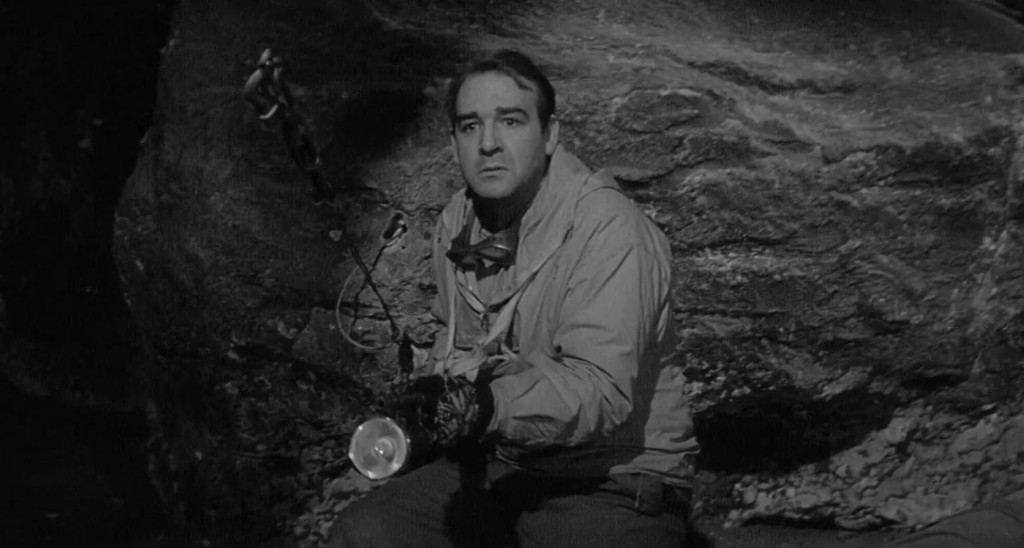
Four different actors played yetis over the course of the film, including stuntman Joe Powell and Hammer bit-part staple Fred Johnson. For the shot where the yeti reveals himself to Rollason, Guest hired bit-part actor John Rae, because of his wise and kind eyes.
The Abominable Snowman was produced by Aubrey Baring – the only film he produced for Hammer.
Janne Wass
The Abominable Snowman. 1957, UK. Directed by Val Guest. Written by Nigel Kneale & Val Guest. Based on the teleplay The Creature by Nigel Kneale. Starring: Peter Cushing, Forrest Tucker, Maureen Connell, Richard Wattis, Robert Brown, Michael Brill, Wolfe Morris, Arnold Marlé, Anthony Chinn. Music: Humphrey Searle. Cinematography: Arthur Grant. Editing: Bill Lenny. Production design: Bernard Robertson. Makeup: Philip Leakey. Sound: Jock May. Produced by Aubrey Baring for Clarion Films (Regal Pictures) and Hammer Films.

Leave a comment